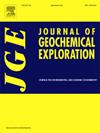西澳大利亚卡尔皮尼Emu湖科马铁矿岩浆型硫化镍远景区新靶区圈定
IF 3.3
2区 地球科学
Q1 GEOCHEMISTRY & GEOPHYSICS
引用次数: 0
摘要
本研究测试了岩石地球化学和指示矿物分析的应用,以圈定西澳大利亚太古代东部金矿区超地体中鸸鹋湖科马岩浆岩硫化物远景区的新勘探目标。块状硫化物最近在一个被非正式地称为西部超镁铁质的科马铁矿单元的基底接触处被截获。这种矿化的程度很难沿着超基性层序~15 km的走向长度进行追踪,因为上覆和下伏有多处裸露的科马铁矿流动和明显的断层偏移。全岩地球化学表明,西部超基性单元的Ni/Cr比值明显低于该层序中其他超基性单元的Ni/Cr比值,处于槽状片流科马提岩相的第50百分位范围内。该镍铬比有助于将含镍硫化物单元与其他科马长岩流区区分开来,并用于勾勒出进一步钻探成功发现硫化物的新目标。鸸鹋湖远景区指示矿物主要为砷化物和铬铁矿。西部超镁铁质中铬铁矿的Ru含量低于其他超镁铁质单元,表明硅酸盐和硫化物熔体之间存在相互作用。鸸鹋湖也存在砷化物,其Pd/Pt值表明富砷流体与剪切带或断裂带岩浆硫化物聚集相互作用。在鸸鹋湖远景区矿化区上方采集的地表样品含有硫化物(镍黄铁矿和黄铜矿)。地表原生硫化物有潜力成为一种强有力的离地指示矿物,可用于绿地地体的岩浆硫化物勘探。本文章由计算机程序翻译,如有差异,请以英文原文为准。

Delineating new targets in a komatiite-hosted magmatic nickel sulfide prospect - Emu Lake, Kalpini, Western Australia
This study tests the use of litho-geochemistry and indicator mineral analysis to delineate new exploration targets within the Emu Lake komatiite-hosted magmatic sulfide prospect within the Archean Eastern Goldfields Superterrane of Western Australia.
Massive sulfide was recently intercepted at the basal contact of a komatiite unit informally known as the Western ultramafic. The extent of this mineralisation is difficult to track along the ~15 km strike length of the ultramafic sequence due to multiple overlying and underlying barren komatiite flows and significant fault offsets. Whole-rock geochemistry shows that the Western ultramafic unit has distinctly lower Ni/Cr ratios than other ultramafic rocks in the sequence and sits firmly within the 50th percentile of channelised sheet flow komatiitic facies. This Ni/Cr ratio helps distinguish the nickel sulfide-bearing unit from the other komatiitic flows and was used to outline a new target where further drilling was successful in finding sulfide.
Indicator minerals within the Emu Lake prospect consist of arsenides and chromite. Chromites within the Western ultramafic have lower Ru contents than those within the other ultramafic units, marking interaction between silicate and sulfide melts. Arsenides are also present at Emu Lake and their Pd/Pt values signify arsenic-rich fluids interacted with magmatic sulfide accumulation along shear or fault zones. Surface samples collected above the mineralised area at the Emu Lake prospect contained sulfides (pentlandite and chalcopyrite). Primary sulfides sampled at the surface have the potential to be a powerful ex-situ indicator mineral and could be applied to magmatic sulfide exploration in greenfield terranes.
求助全文
通过发布文献求助,成功后即可免费获取论文全文。
去求助
来源期刊

Journal of Geochemical Exploration
地学-地球化学与地球物理
CiteScore
7.40
自引率
7.70%
发文量
148
审稿时长
8.1 months
期刊介绍:
Journal of Geochemical Exploration is mostly dedicated to publication of original studies in exploration and environmental geochemistry and related topics.
Contributions considered of prevalent interest for the journal include researches based on the application of innovative methods to:
define the genesis and the evolution of mineral deposits including transfer of elements in large-scale mineralized areas.
analyze complex systems at the boundaries between bio-geochemistry, metal transport and mineral accumulation.
evaluate effects of historical mining activities on the surface environment.
trace pollutant sources and define their fate and transport models in the near-surface and surface environments involving solid, fluid and aerial matrices.
assess and quantify natural and technogenic radioactivity in the environment.
determine geochemical anomalies and set baseline reference values using compositional data analysis, multivariate statistics and geo-spatial analysis.
assess the impacts of anthropogenic contamination on ecosystems and human health at local and regional scale to prioritize and classify risks through deterministic and stochastic approaches.
Papers dedicated to the presentation of newly developed methods in analytical geochemistry to be applied in the field or in laboratory are also within the topics of interest for the journal.
 求助内容:
求助内容: 应助结果提醒方式:
应助结果提醒方式:


